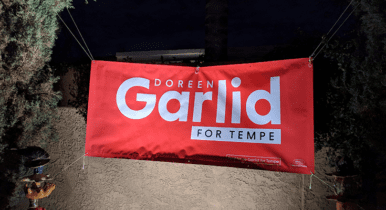Yard Signs Don’t Vote: 3 Critical Things to Focus On Instead


“When do we order lawn signs?”
This is one of the most common questions I’ve been asked as a consultant for the past decade, and my answer is always the same: “We don’t.”
Seasoned campaign professionals know better than to waste precious donor dollars – and the most precious of all, your time – on tactics that are not direct voter contact. Direct contact refers to tactics including calling or texting voters and knocking doors of those who can be persuaded to vote for your candidate or who are already in but need extra encouragement to turn out to the polls.
Yet the impulse of candidates, their volunteers, and even members of ballot initiative committees is often to invest in yard signs, particularly during moments of stress in the campaign.
There comes a point in every campaign when “all ideas are on the table,” which tends to be a reflection of the collective sense of chaos as Election Day approaches, rather than the approved, thought-out strategy.
Don’t let yourself become distracted from the tactics that work, particularly when ideas start hitting you like ping-pong balls from all corners of the campaign headquarters.
Focusing on what truly moves voters will prevent you and your candidate from making some of the most common mistakes that lead to unsuccessful campaigns. Here are three tips to help you keep your eyes on the prize: a win on Election Day that also feels like a win for the community you seek to represent.
1. Ditch the flashy stuff and prioritize building genuine relationships.
Candidates often think that they have to have a gorgeous website to launch a campaign, but it’s much more important to have a strategy for how they will reach people and what they will say to convince voters to believe in them.
Truly strong leaders show up in their communities, but beyond that, they also show up in the parts of the communities where they might not naturally fit in or be comfortable. They do this to connect, to listen, and to learn about what issues are facing their constituents to better solve those problems once elected.
Earnestness counts in your approach, and it should inform your calendar all year long, not just during election season. Communities, particularly those that have been historically marginalized, can easily sniff out a fake who only shows up to events and meetings only when they’re running for office.
2. Define yourself first, not your opponent.
Just like voters can spot someone who’s only pretending to care about them, they also tend to be rightfully skeptical of candidates who show up only because they have a personal axe to grind. These candidates may have a chip on their shoulder or are primarily running because they don’t like the other person. They’ll even kick off their campaign by using “I’m not so-and-so” as a key argument. This is tempting, especially when the other person on the ballot is really, well, awful.
People want to vote for people, not someone who is mainly qualified because they’re not the incumbent. Voters want to know your story, the issues that motivate you to run, and the values you will live by once elected.
Differentiating from your opponent can be a more effective strategy at the end of the campaign, but usually won’t work at the beginning. Once you’ve spent several months proactively defining who you are and what you stand for, then you can tackle defining your opponent.
Don’t waste critical moments in the early stages of a campaign talking about your opponent when you can instead be telling a compelling story about yourself, your candidacy, and your vision.
3. Choose data, not drama.
Around the time a candidate or their volunteers start floating the idea of more yard signs, drama may feel high. Maybe there’s been some transition, a negative article in the press. Or maybe you’re just getting started and the nerves have set in: “How can we possibly win this thing?!” There’s a collective sense of freakout and that things are hard, maybe worse than they actually are.
The team is expending so much energy by feeling worried and stressed that these feelings take on a life of their own, making folks more stressed out and far less effective. Everyone gets tired and feels drained of energy. The stress can strain team dynamics, make people cranky, and alienate would-be volunteers. The feeling is valid, but it’s not a place to stagnate or from which to make decisions.
As a leader of your campaign team, you can model good choices, like stepping away from the laptop and going for a walk, going for a quick workout class, or eating a healthy meal. Crank up “Shake it Off” and have a Taylor Swift-themed dance party in your campaign office. Find out favorite candies in the office and stop by the corner store for some treats. Whatever does the trick, encourage everyone around you to occasionally pause to regulate their nervous systems. You’ll make better decisions once folks are more rested and focused.
Once you’re zoned back in on the job at hand, take a deep breath and review your plan and your progress. Look at the data that matters: Dials, door knocks, and yes, dollars. Where are you in relation to the plan you put in place?
The single best thing you can do as a campaign consultant or team member is help everyone take a deep breath and remind them of the well-crafted strategy everyone agreed to. Grounding into the campaign strategy and only investing time and money in tactics that prioritize listening to and connecting with potential voters are the best ways to get your team through to an electoral victory everyone can be proud of.
Kathleen Stuart is the founder of Stuart Collective, which provides public affairs consulting, political strategy, communications and campaign services to leading nonprofits, state agencies, labor unions, and political action committees across the West.


